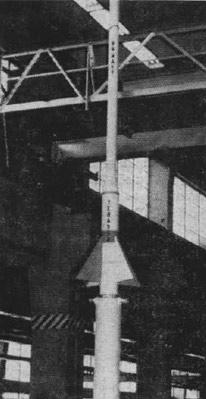
A sounding rocket or rocketsonde, sometimes called a research rocket or a suborbital rocket, is an instrument-carrying rocket designed to take measurements and perform scientific experiments during its sub-orbital flight. The rockets are used to launch instruments from 48 to 145 km above the surface of the Earth, the altitude generally between weather balloons and satellites; the maximum altitude for balloons is about 40 km and the minimum for satellites is approximately 121 km. Certain sounding rockets have an apogee between 1,000 and 1,500 km, such as the Black Brant X and XII, which is the maximum apogee of their class. Sounding rockets often use military surplus rocket motors. NASA routinely flies the Terrier Mk 70 boosted Improved Orion, lifting 270–450-kg (600–1,000-pound) payloads into the exoatmospheric region between 97 and 201 km.

The Delta rocket family was a versatile range of American rocket-powered expendable launch systems that provided space launch capability in the United States from 1960 to 2024. Japan also launched license-built derivatives from 1975 to 1992. More than 300 Delta rockets were launched with a 95% success rate. The series was phased out in favor of the Vulcan Centaur, with the Delta IV Heavy rocket's last launch occurring on April 9, 2024.

The Convair RIM-2 Terrier was a two-stage medium-range naval surface-to-air missile (SAM), among the earliest SAMs to equip United States Navy ships. It underwent significant upgrades while in service, starting with beam-riding guidance with a 10-nautical-mile (19 km) range at a speed of Mach 1.8 and ending as a semi-active radar homing (SARH) system with a range of 40 nmi (74 km) at speeds as high as Mach 3. It was replaced in service by the RIM-67 Standard ER (SM-1ER).
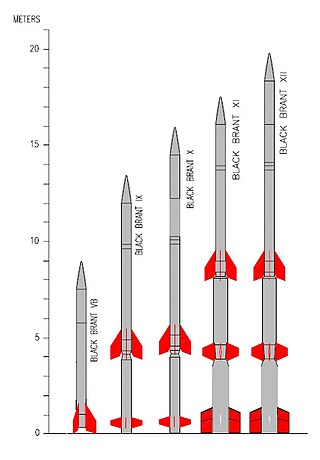
The Black Brant is a family of Canadian-designed sounding rockets originally built by Bristol Aerospace, since absorbed by Magellan Aerospace in Winnipeg, Manitoba. Over 800 Black Brants of various versions have been launched since they were first produced in 1961, and the type remains one of the most popular sounding rockets. They have been repeatedly used by the Canadian Space Agency and NASA.

The Aerojet General X-8 was an unguided, spin-stabilized sounding rocket designed to launch a 150 lb (68 kg) payload to 200,000 feet (61.0 km). The X-8 was a version of the prolific Aerobee rocket family.
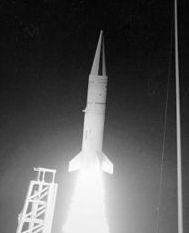
Aries is an American sounding rocket and target rocket, developed by Space Vector Corporation from retired LGM-30 Minuteman I intercontinental ballistic missile (ICBM) stages for use by the United States Air Force and NASA. Taken over by Orbital Sciences Corporation, Aries, as the Target Test Vehicle, remains in use.
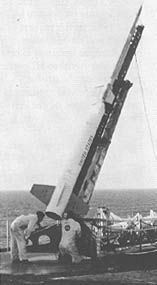
The Nike Apache, also known as Argo B-13, was a two-stage sounding rocket developed by Aerolab, later Atlantic Research, for use by the United States Air Force and NASA. It became the standard NASA sounding rocket and was launched over 600 times between 1961 and 1978.

Cajun Dart is the designation of an American sounding rocket. The Cajun Dart was used 87 times between 1964 and 1970. The Cajun rocket motor was developed from Deacon.
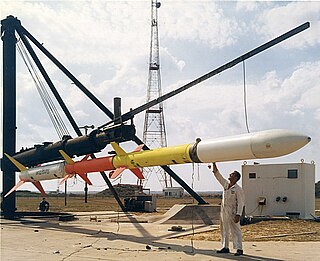
Javelin was the designation of an American sounding rocket. The four stage Javelin rocket had a payload of around 125 pounds, an apogee of 1100 kilometers, a liftoff thrust of 365 kilonewtons, a total mass of 3,385 kilograms (7,463 lb), and a core diameter of 580 millimeters (22.8 in). It was launched 82 times between 1959 and 1976.
The Nike-Cajun was a two-stage sounding rocket built by combining a Nike base stage with a Cajun upper stage. The Nike-Cajun was known as a CAN for Cajun And Nike. The Cajun was developed from the Deacon rocket. It retained the external size, shape and configuration of the Deacon but had 36 percent greater impulse than the Deacon due to improved propellant. It was launched 714 times between 1956 and 1976 and was the most frequently used sounding rocket of the western world. The Nike Cajun had a launch weight of 698 kg (1538 lb), a payload of 23 kg (51 lb), a launch thrust of 246 kN (55,300 lbf) and a maximum altitude of 120 km (394,000 ft). It had a diameter of 42 cm and a length of 7.70 m. The maximum speed of the Nike-Cajun was 6,760 km/h (4,200 mph).

Arcas was the designation of an American sounding rocket, developed by the Atlantic Research Corp., Alexandria, Va.
Thor was a US space launch vehicle derived from the PGM-17 Thor intermediate-range ballistic missile. The Thor rocket was the first member of the Delta rocket family of space launch vehicles. The last launch of a direct derivative of the Thor missile occurred in 2018 as the first stage of the final Delta II.

Milton William Rosen was a United States Navy engineer and project manager in the US space program between the end of World War II and the early days of the Apollo Program. He led development of the Viking and Vanguard rockets, and was influential in the critical decisions early in NASA's history that led to the definition of the Saturn rockets, which were central to the eventual success of the American Moon landing program. He died of prostate cancer in 2014.

The Terrier Orion sounding rocket is a combination of the Terrier booster rocket with the Orion rocket used as a second stage. This spin stabilized configuration is most often used by the Goddard Space Flight Center, who operate out of the Wallops Flight Facility for sounding rocket operations. The system supports payloads ranging from 200 to 800 pounds, and is capable of achieving altitudes as high as 120 miles (200 km), but at least 50 miles (80 km), depending on payload size.

The XMQR-13A Ballistic Missile Target System (BMTS) was an unguided target rocket developed by the United States Army during the 1960s, intended for use in the development of missile defense systems. Utilising off-the-shelf parts in four different configurations, the BMTS was utilised in a series of launches in the late 1960s supporting tests of several missile systems.
The Diamondback was a proposed nuclear-armed air-to-air missile studied by the United States Navy's Naval Ordnance Test Station during the 1950s. Intended as an enlarged, nuclear-armed version of the successful Sidewinder missile, Diamondback did not progress beyond the study stage.

The Creative Research On Weapons or Crow program was an experimental missile project developed by the United States Navy's Naval Air Missile Test Center during the late 1950s. Intended to evaluate the solid-fueled integral rocket/ramjet (SFIRR) method of propulsion as well as solid-fueled ramjet engines, flight tests were conducted during the early 1960s with mixed success.
The Cajun was an American sounding rocket developed during the 1950s. It was extensively used for scientific experiments by NASA and the United States military between 1956 and 1976.
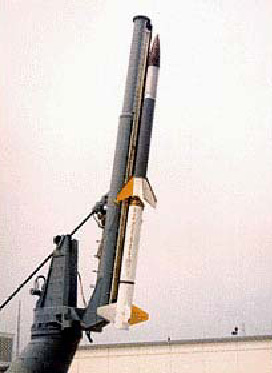
The Terrier Malemute is a two-stage American sounding rocket typically used for smaller payloads. Both the Terrier first stage and the Malemute second stage use solid fuel. The Terrier burns for approximately 5.2 seconds, and the Malemute burns for approximately 21.5 seconds. The first stage booster consists of a surplus Navy Terrier MK 12 Mod 1 rocket motor with four 0.22 m2 (340 sq in) fin panels arranged in a cruciform configuration. The Terrier rocket booster has a diameter of 460 mm (18 in). The second stage solid rocket is a Thiokol Malemute TU-758 rocket motor, specially designed for high altitude research rocket applications. Apogee is approximately 400 km (220 nmi) for a 230 kg (510 lb) payload or 700 km (380 nmi) for a 41 kg (90 lb) payload. For a payload weight of 200 lb (91 kg), the acceleration during the boost phase is 26 g. Its first flight was on November 11, 1974, from Barking Sands. Other launch sites have included Poker Flat, Wallops Island and Fort Yukon, Alaska.
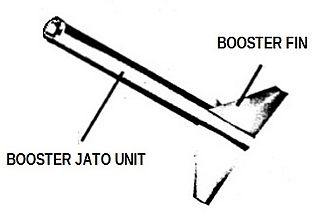
The Nike stage or Nike booster, a solid fuel rocket motor, was created by Hercules Aerospace for the Nike Ajax (M5) Nike Hercules (M5E1). It was developed for use as the first stage of the Nike Ajax and Nike Hercules missiles as part of Project Nike.
